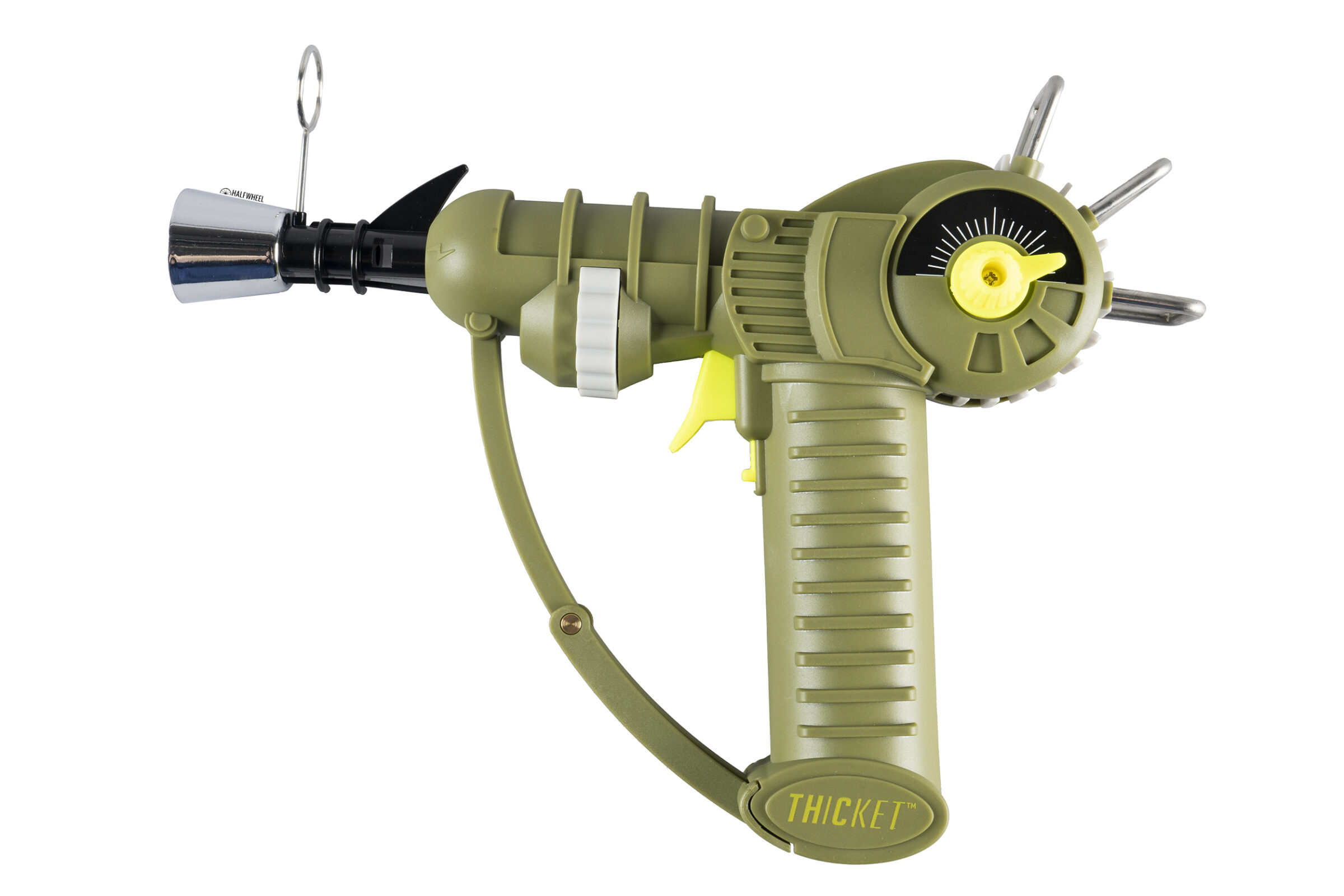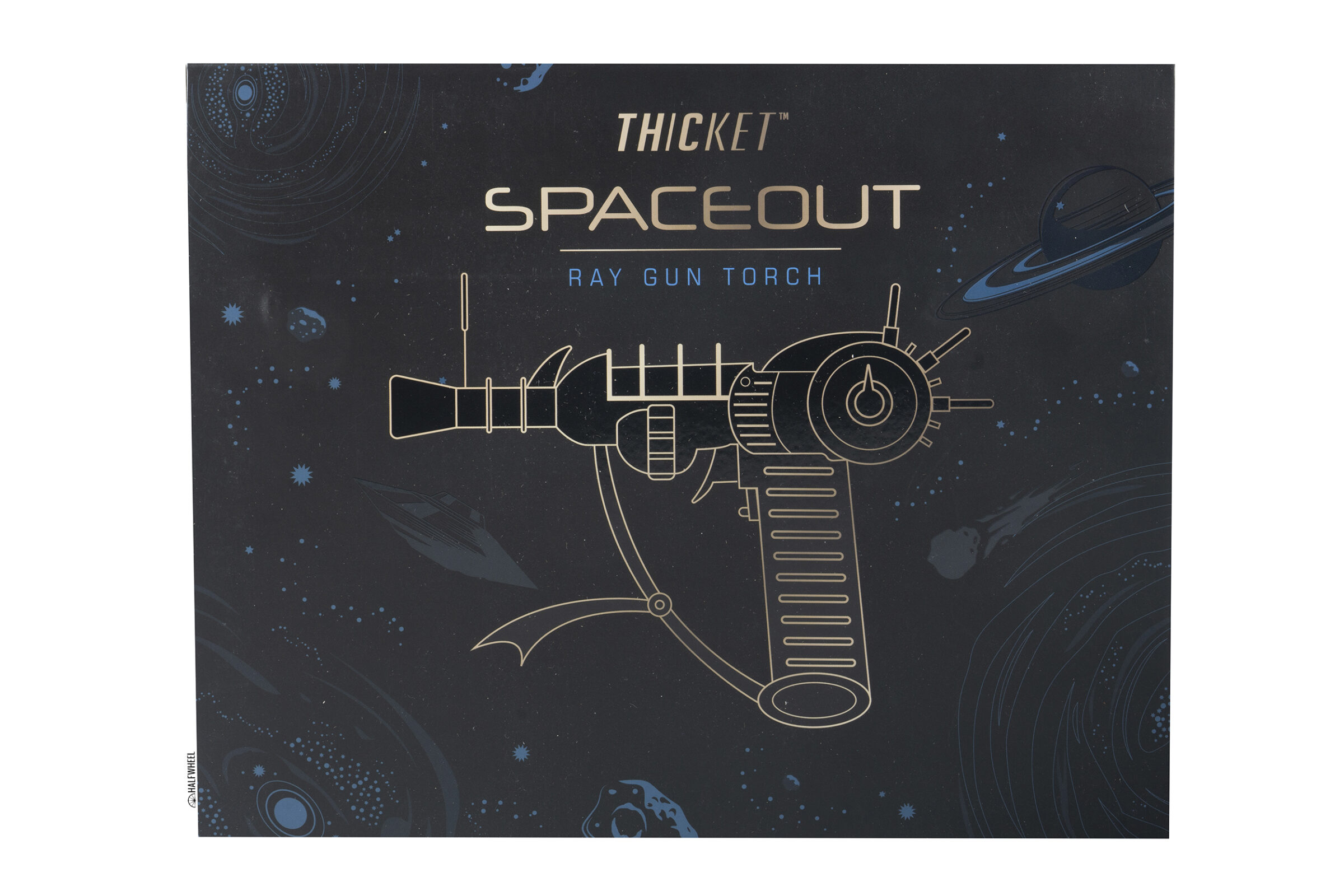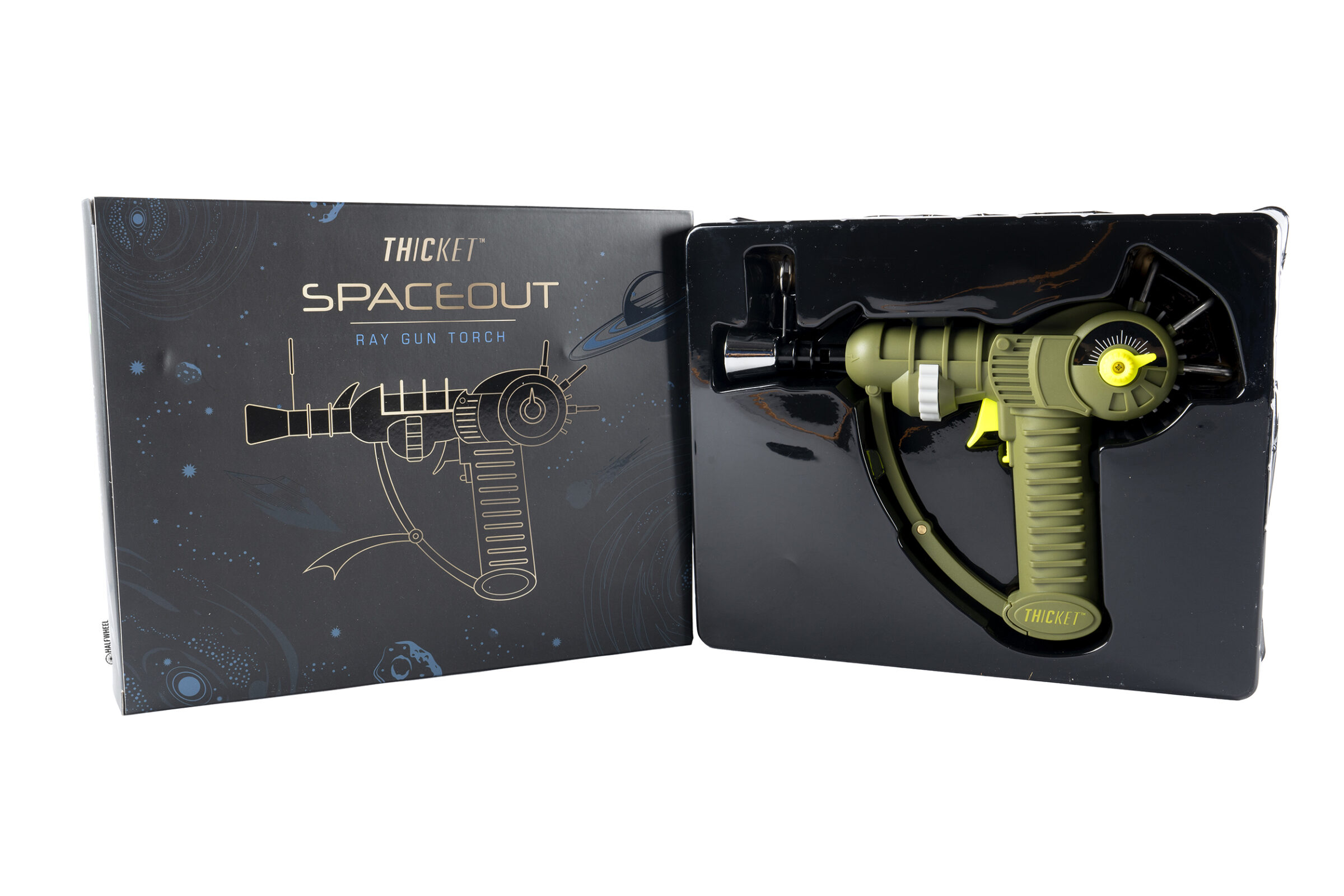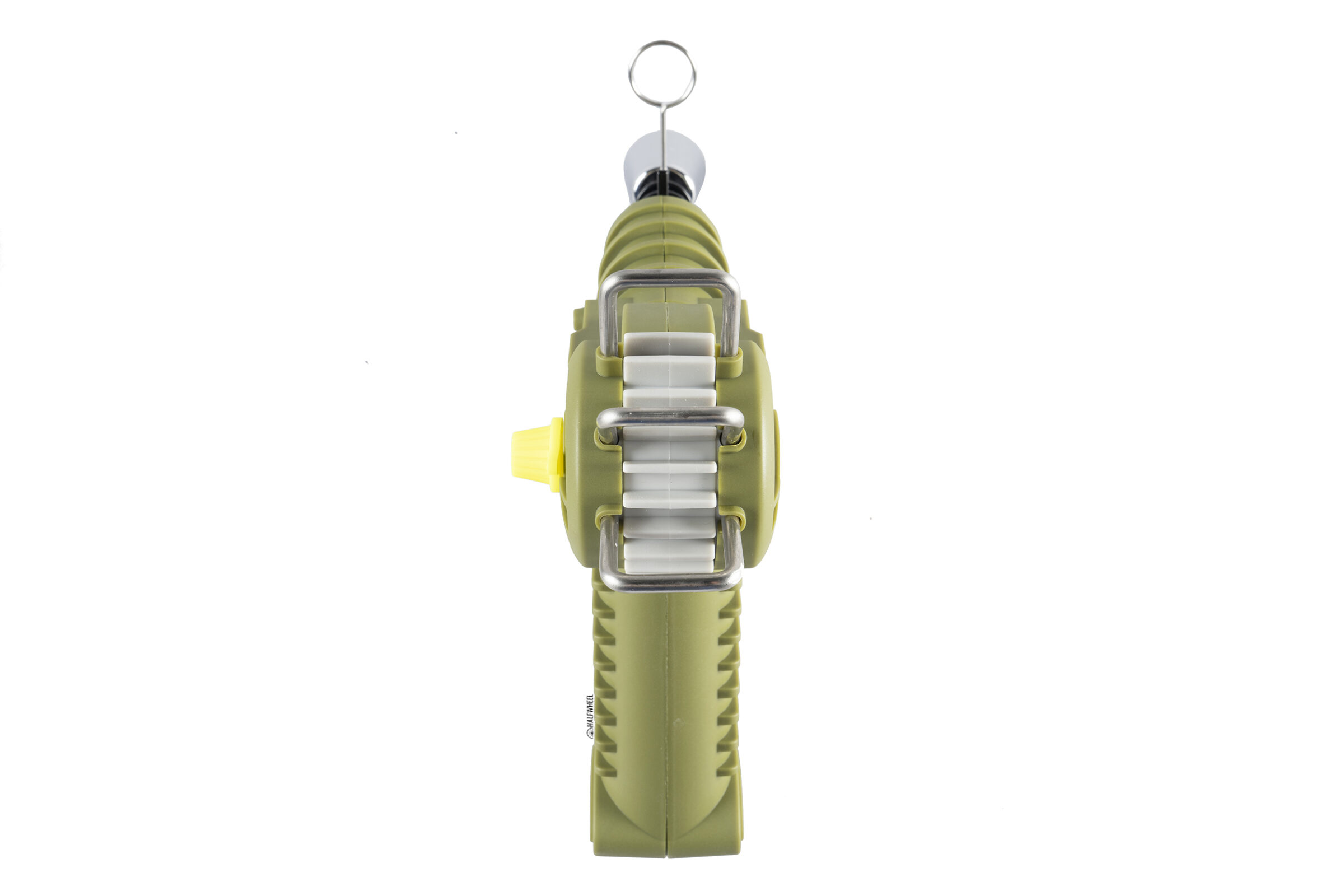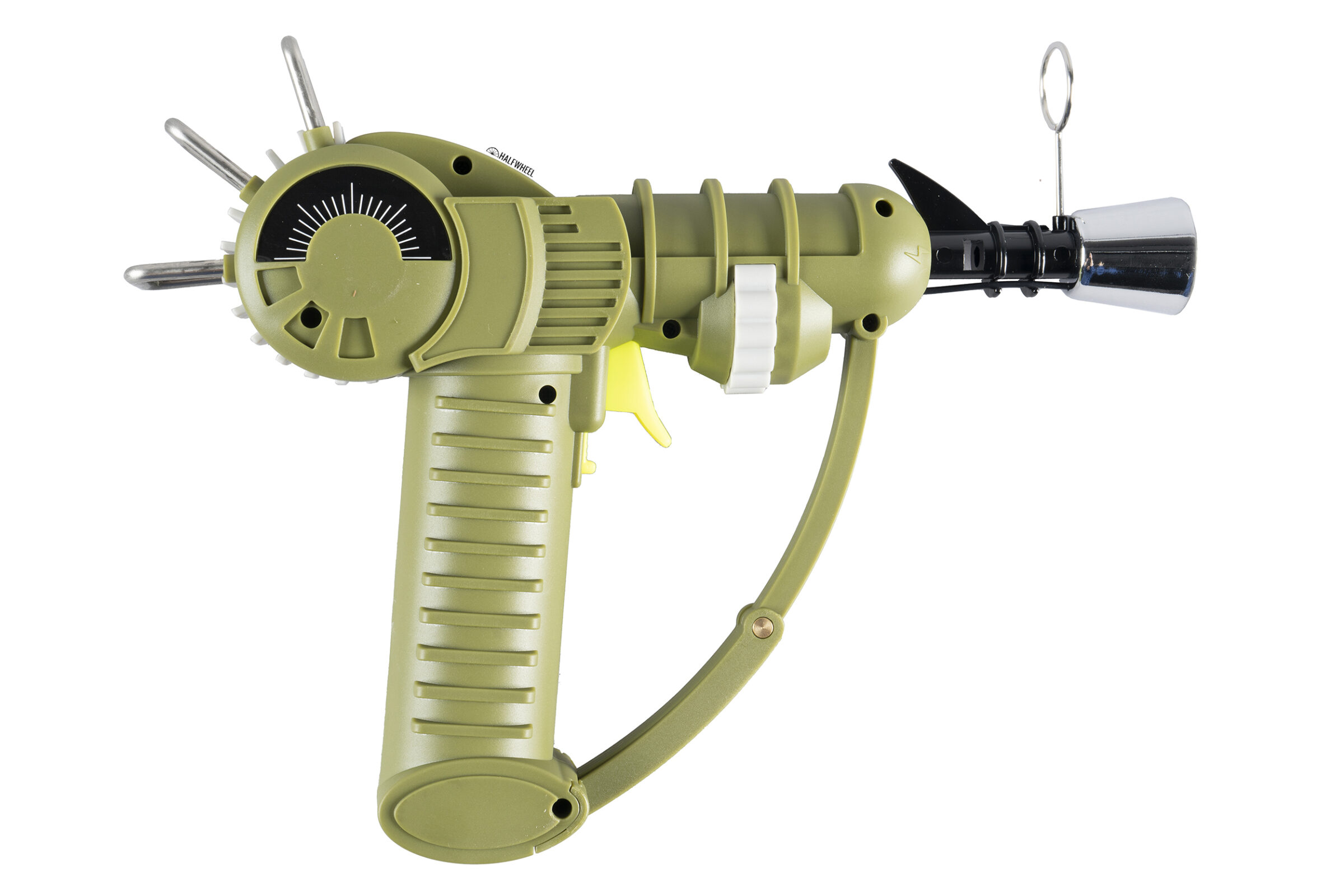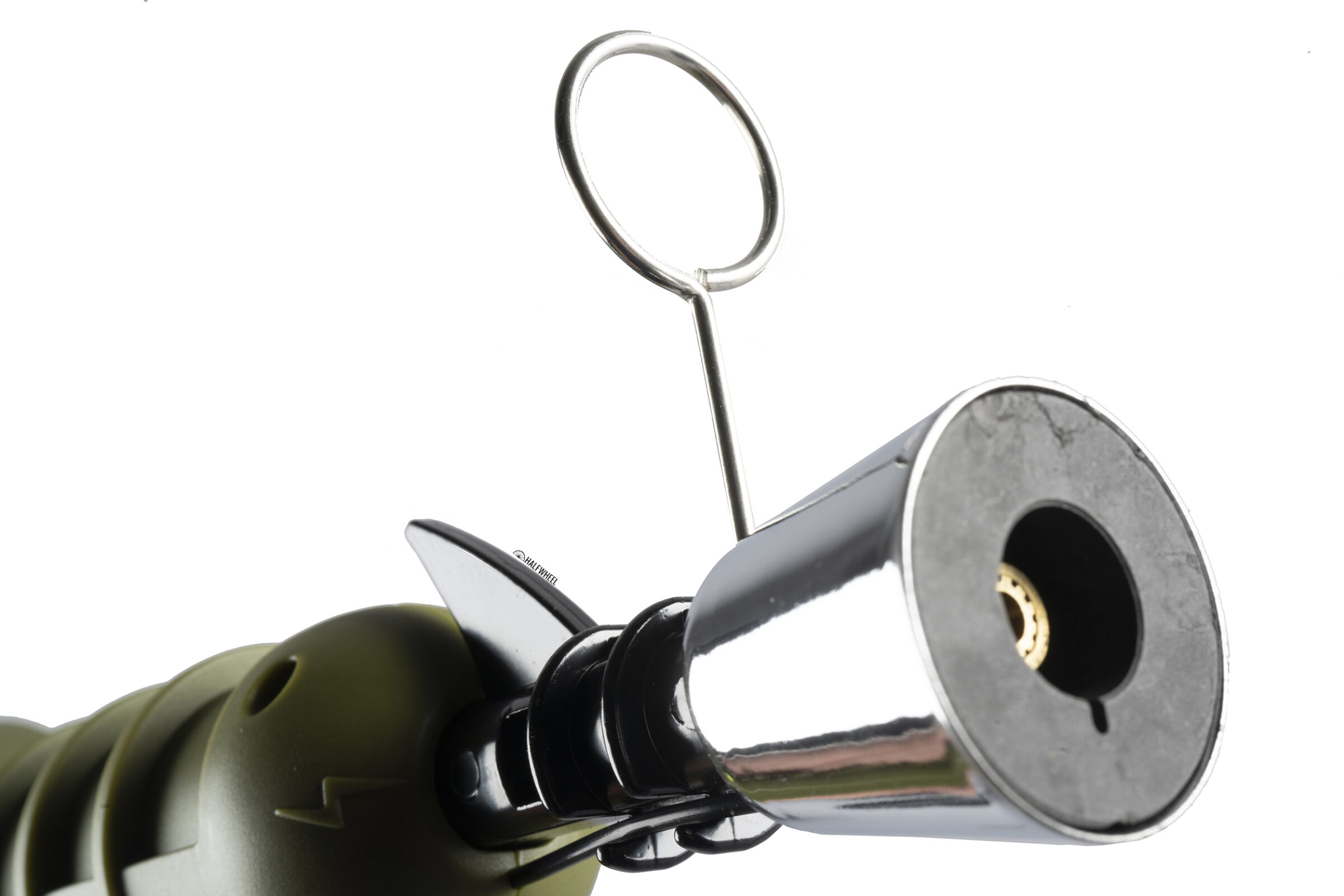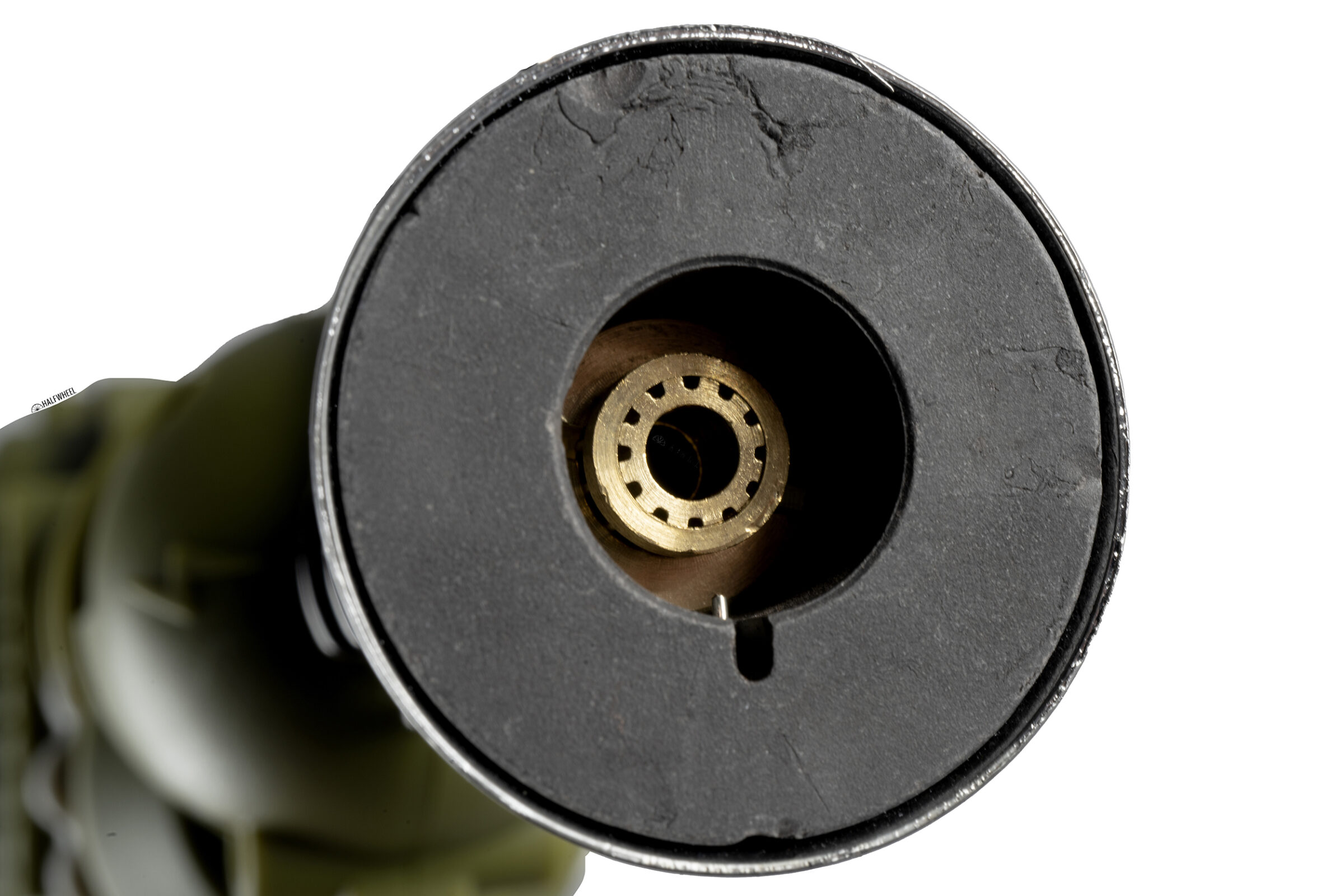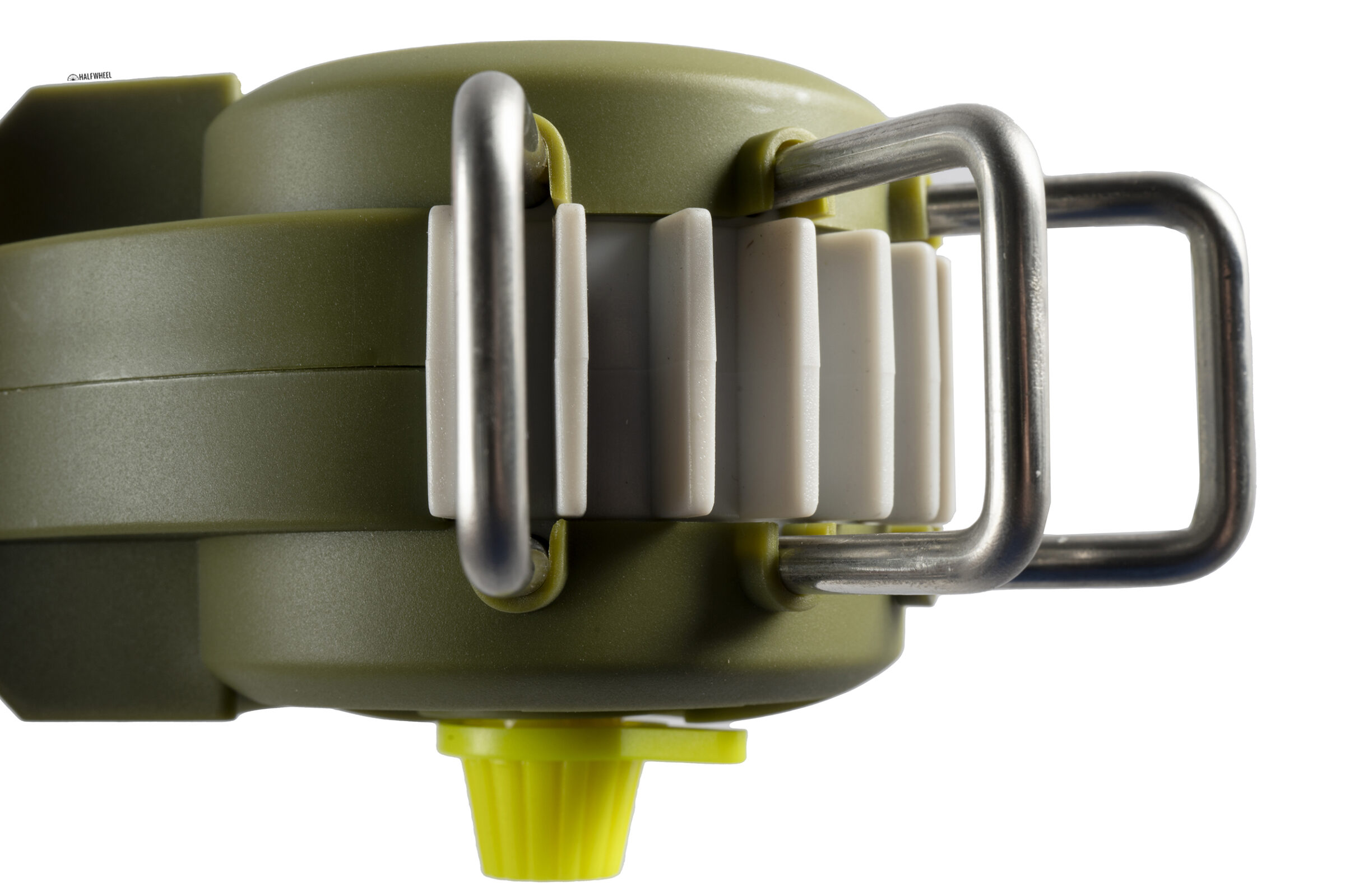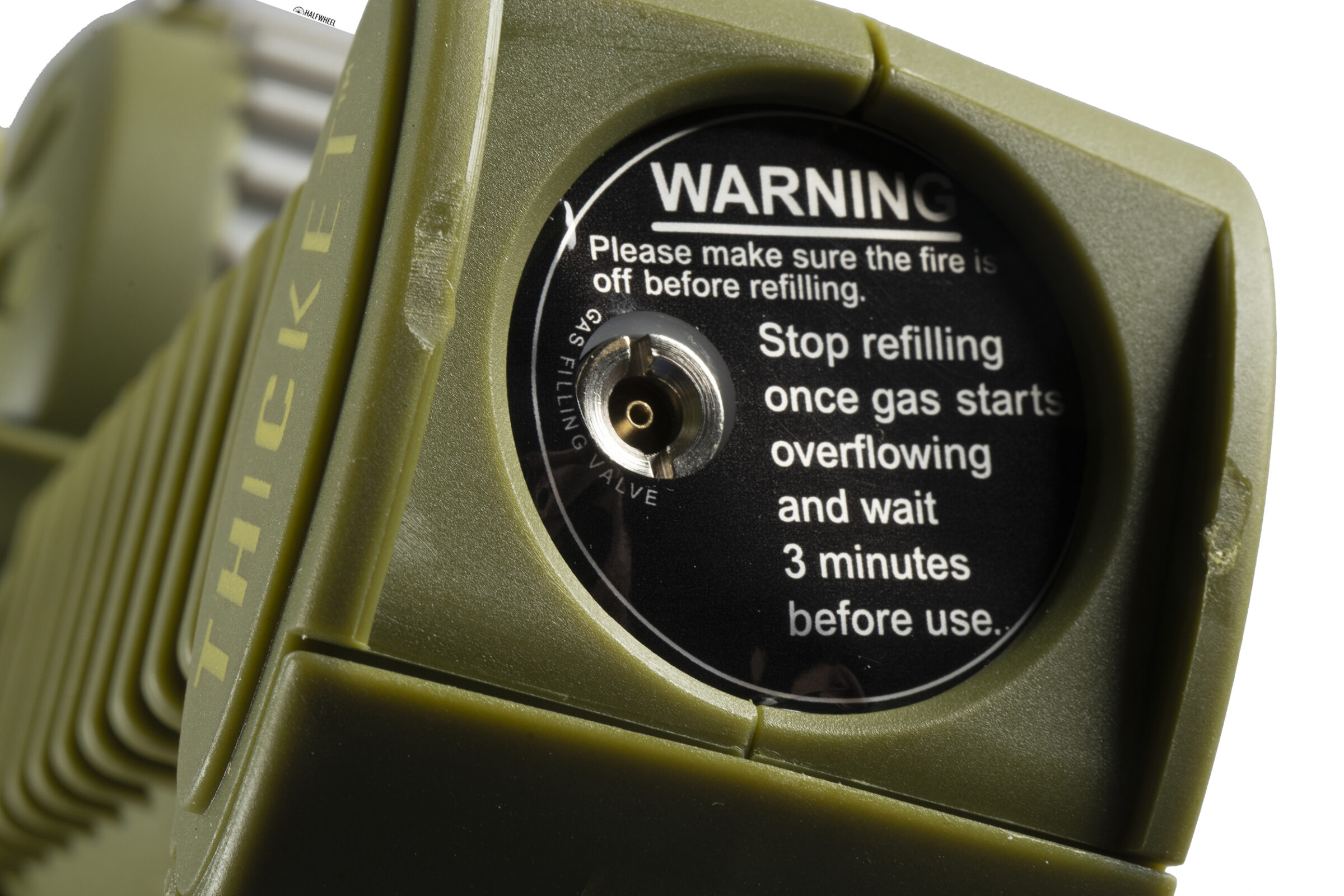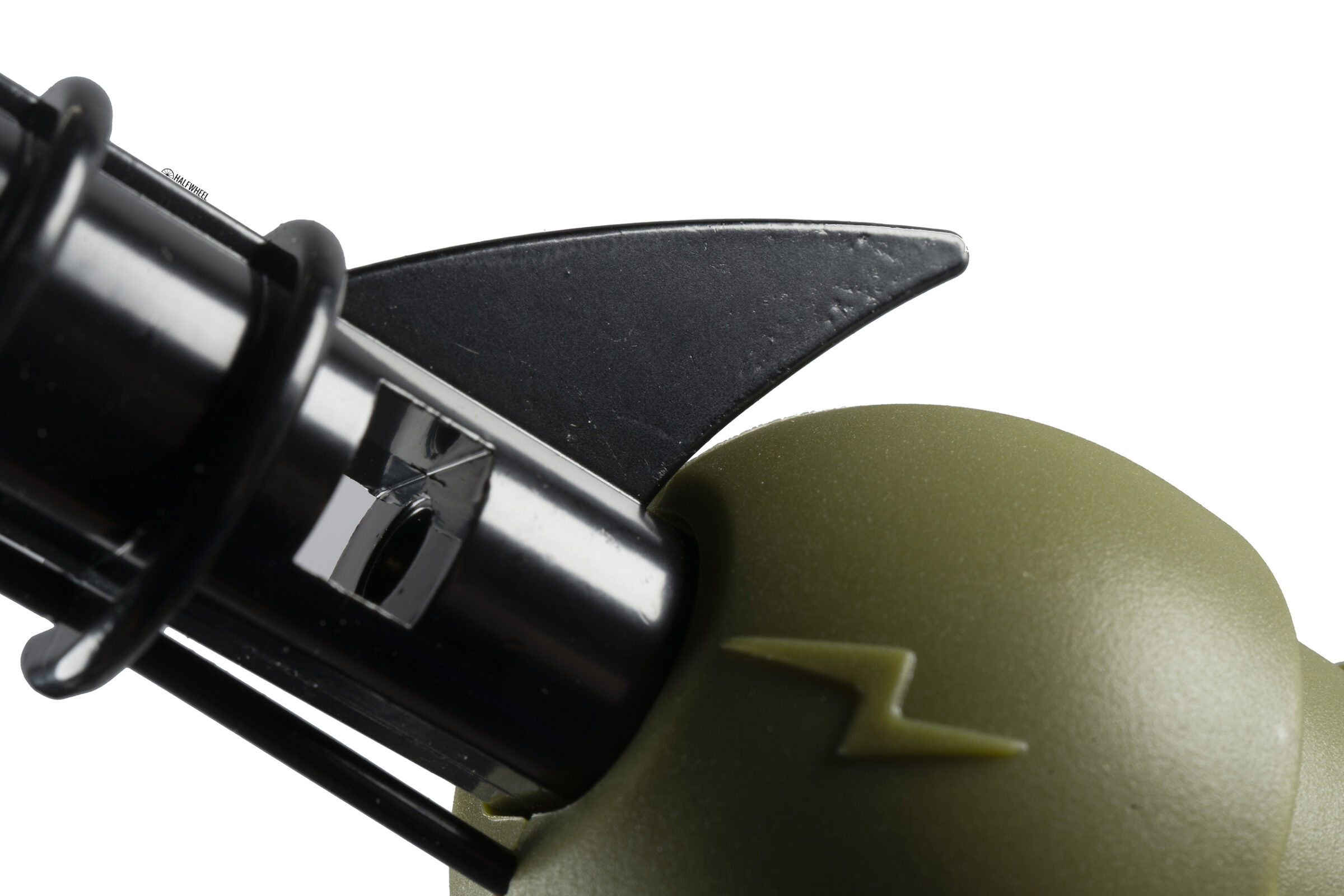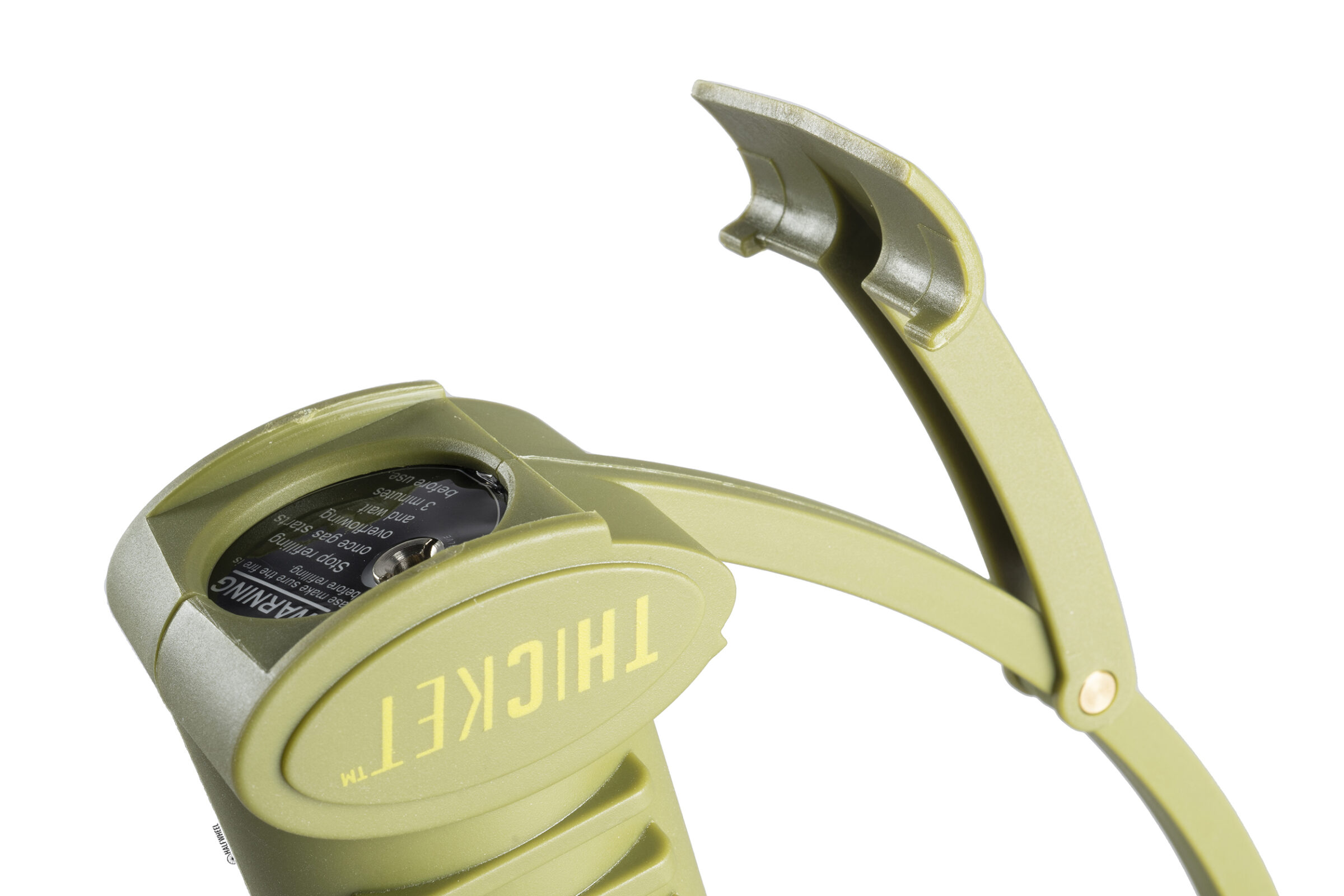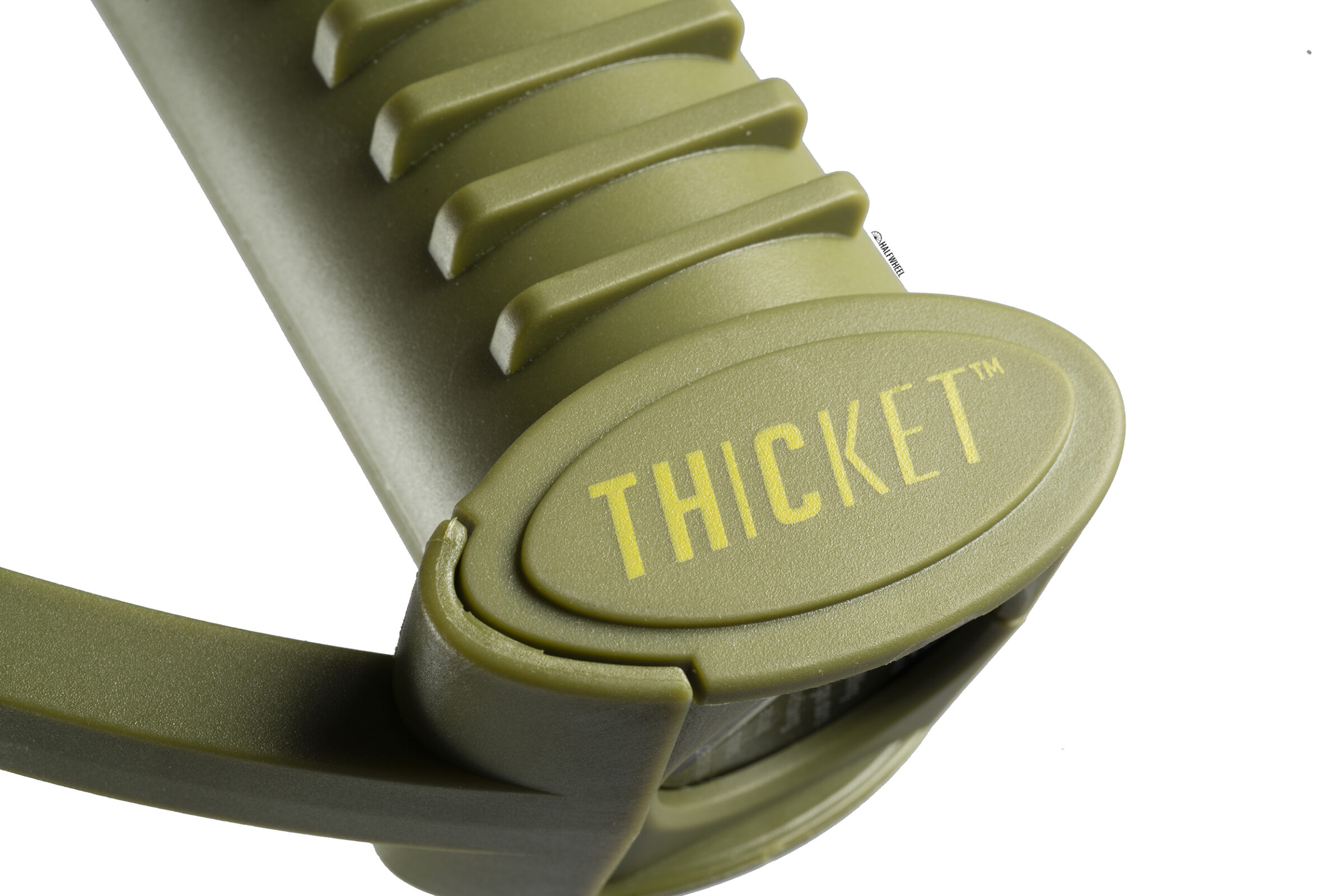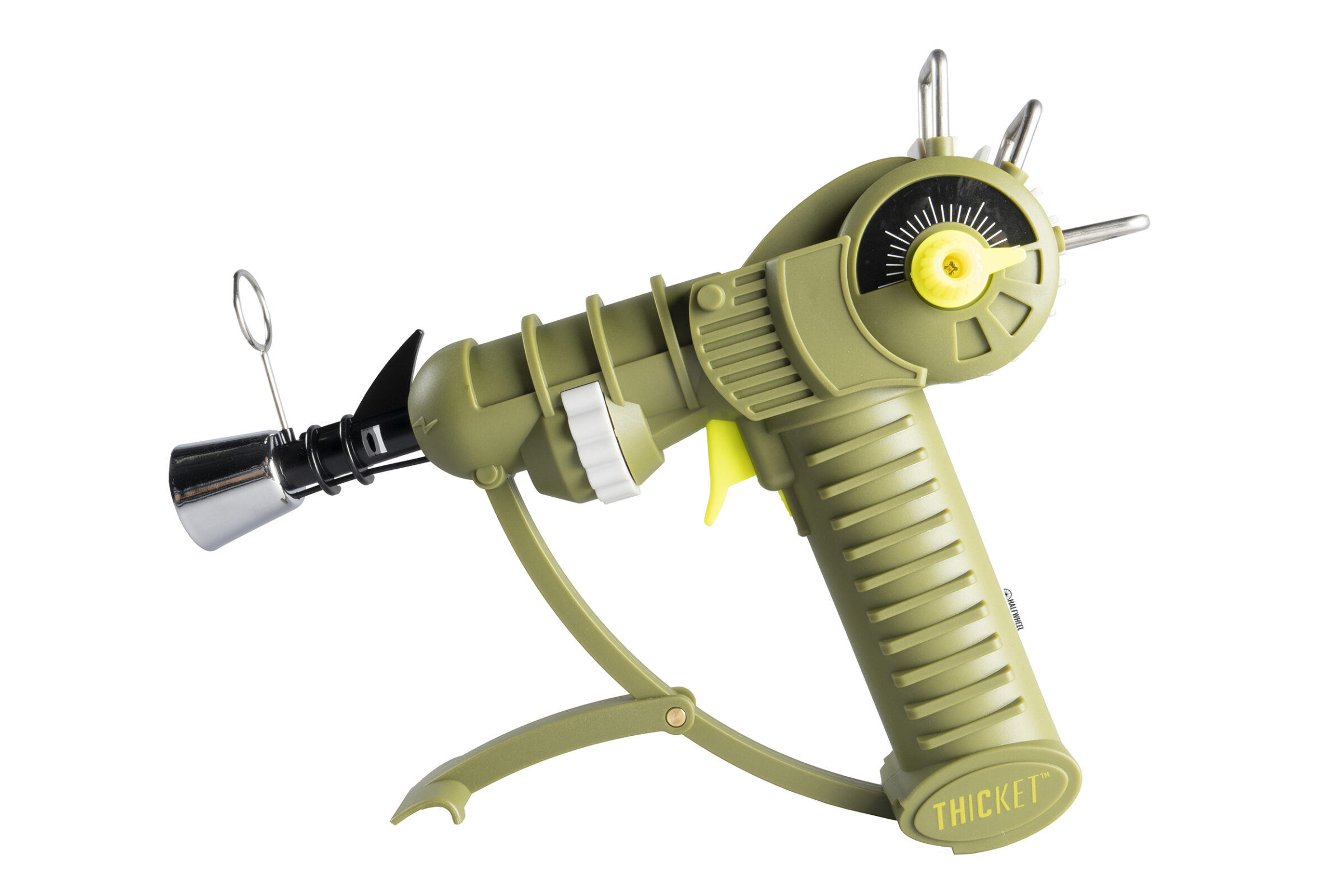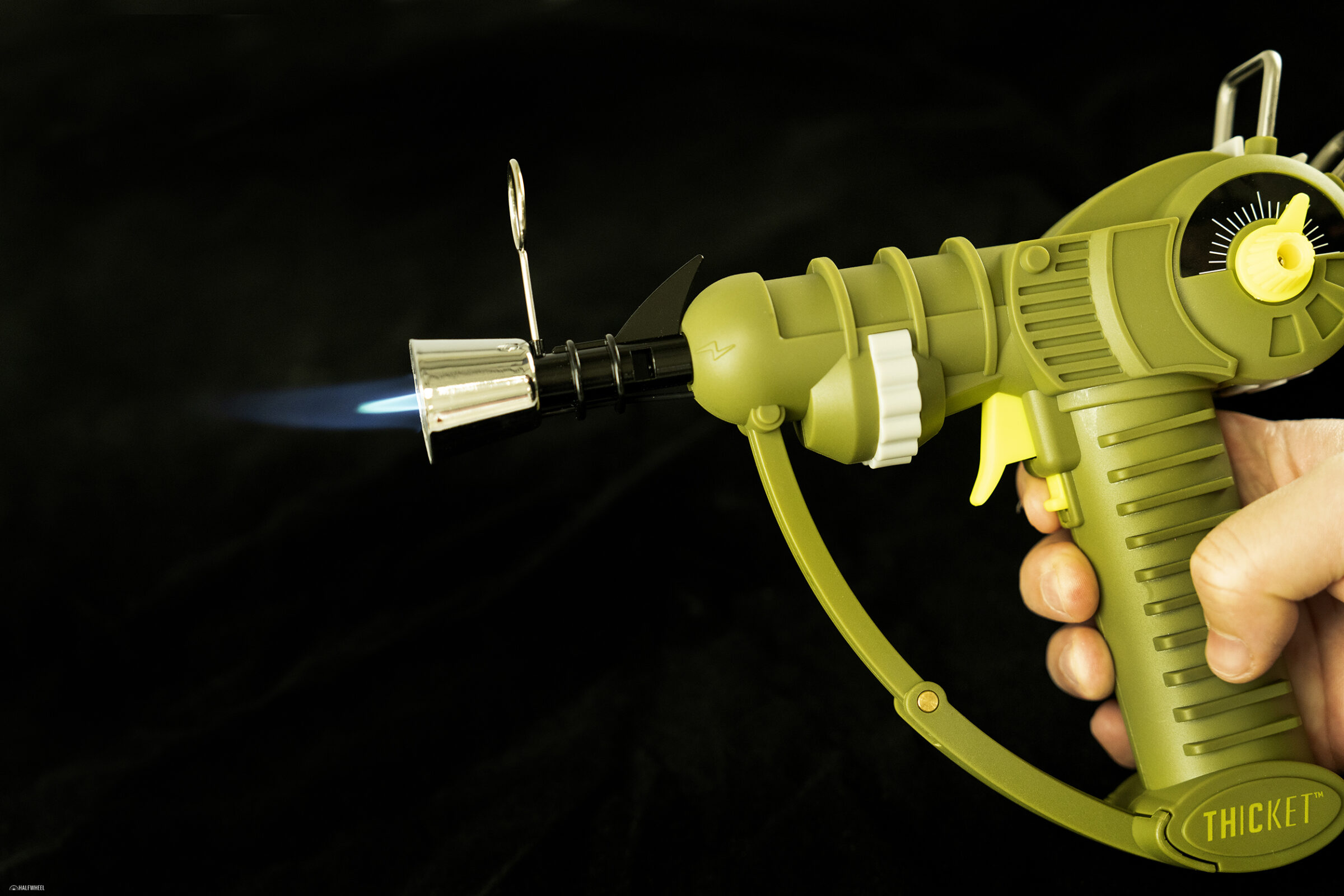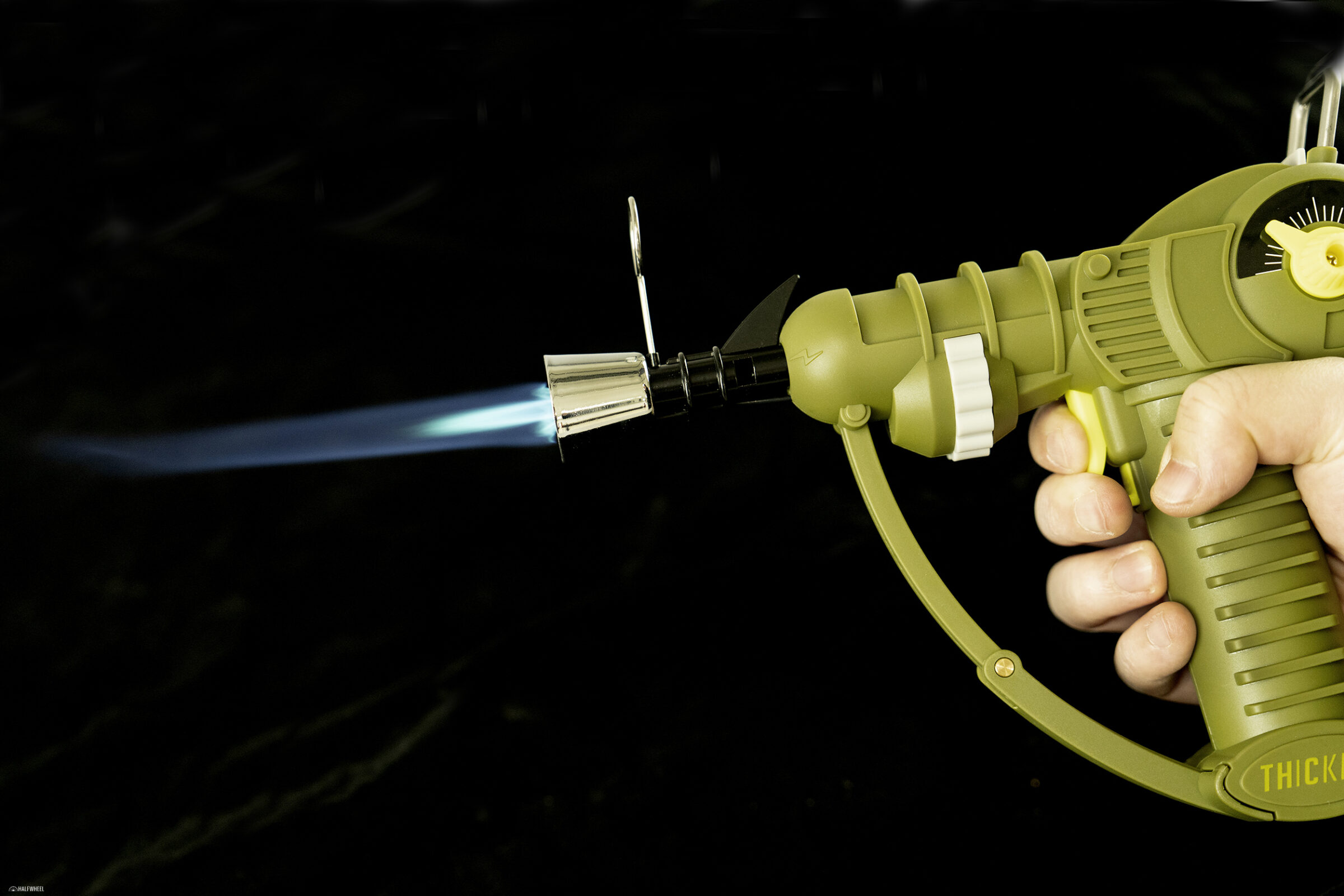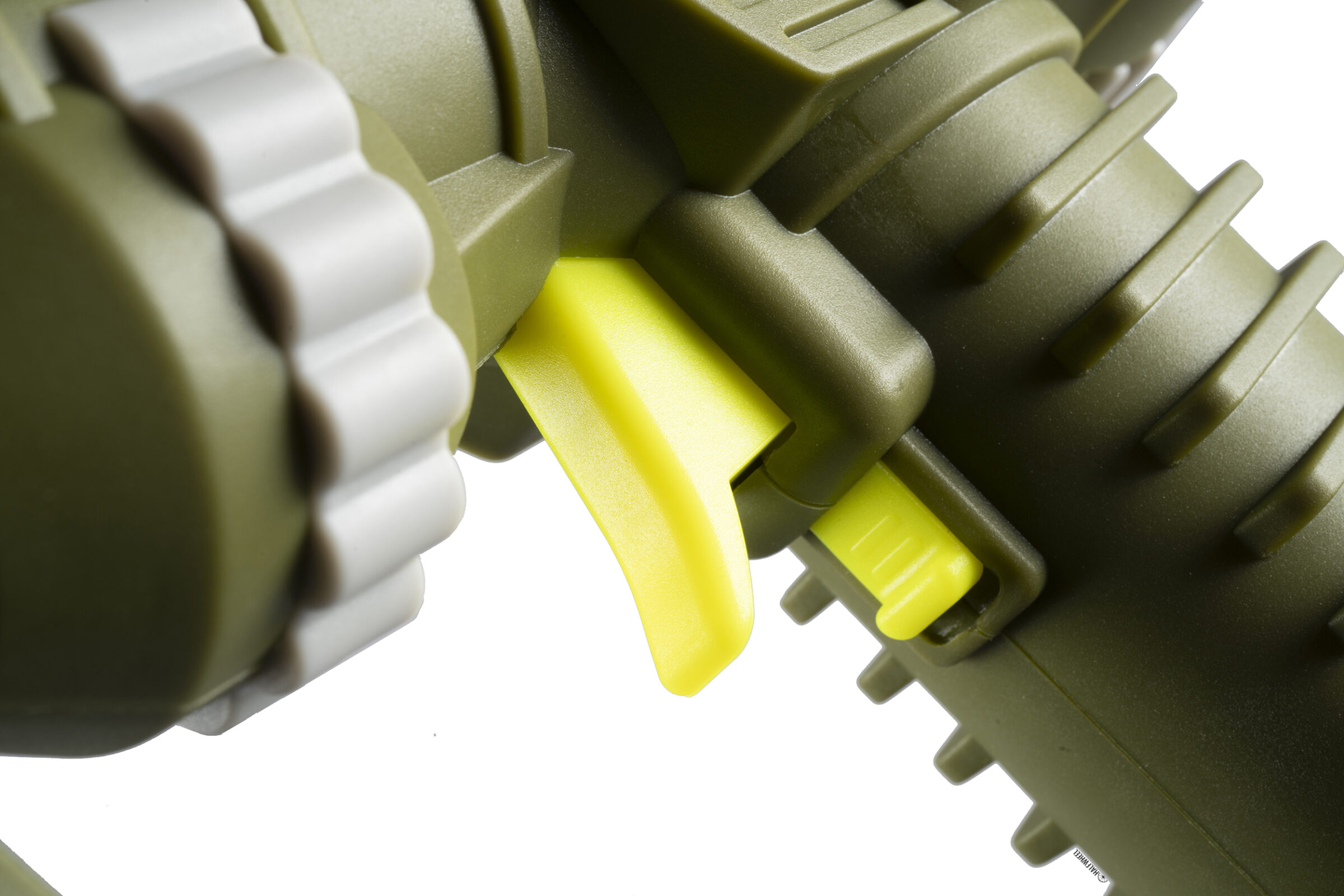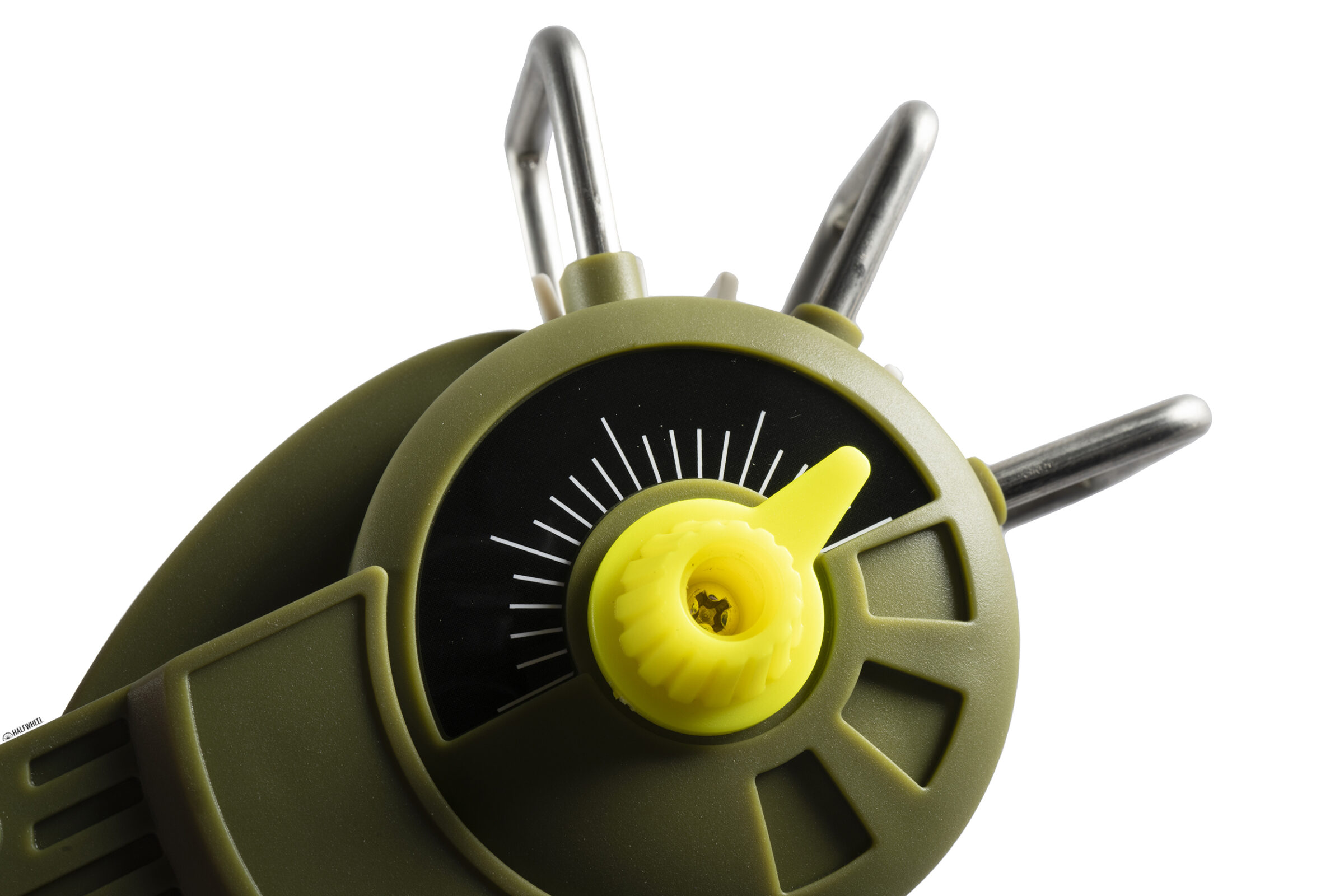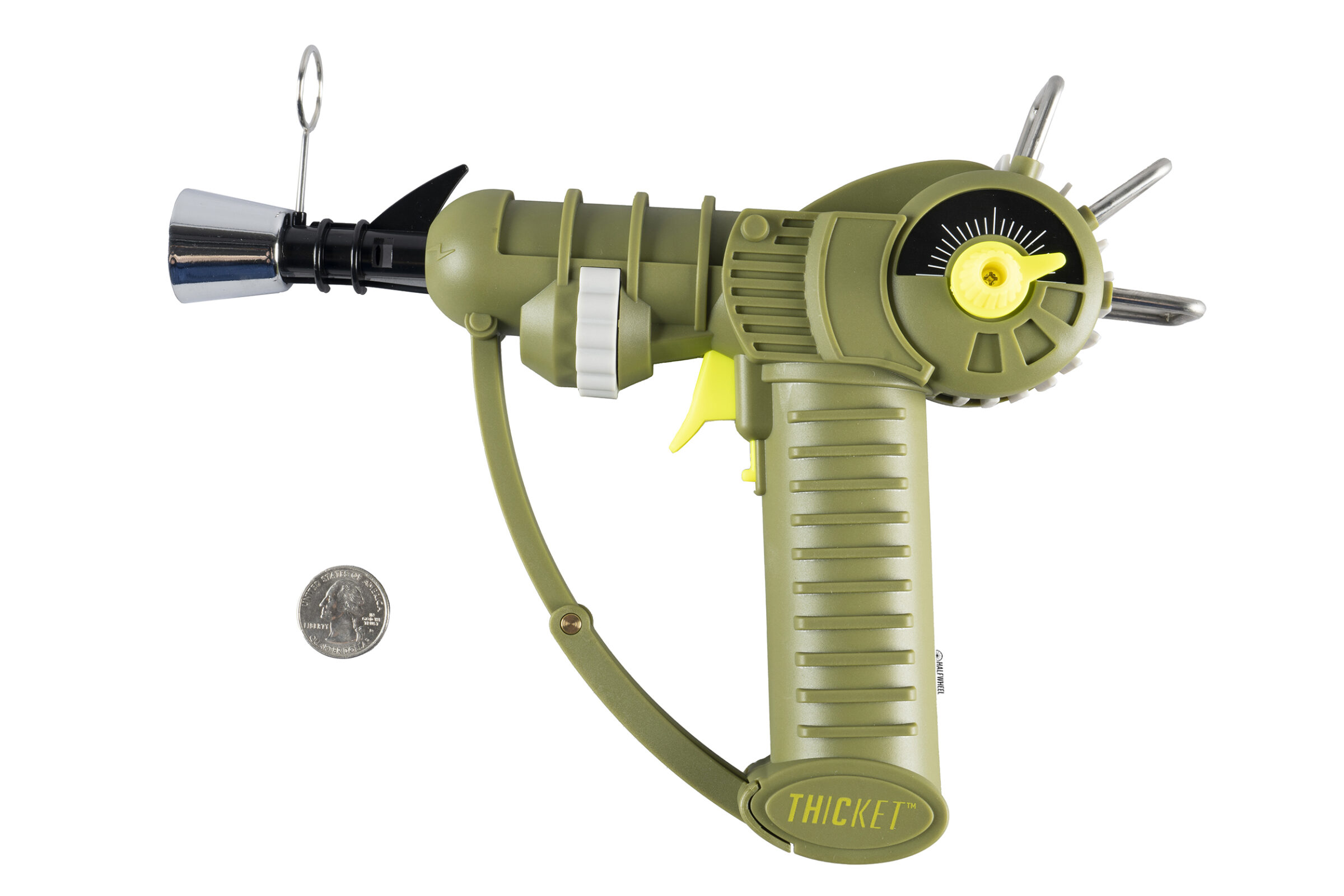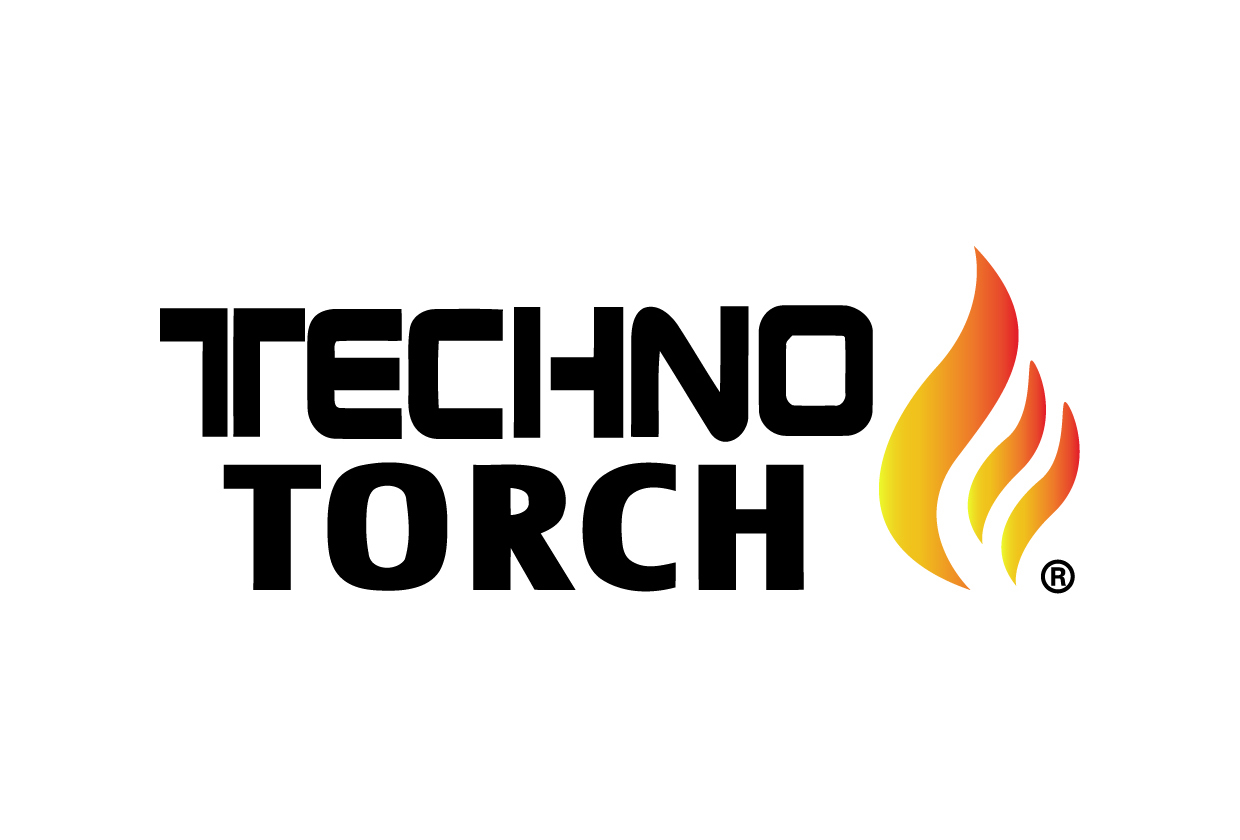Having reviewed lighters from all the familiar cigar accessory makers, it seemed time to branch out and look for an option from a company that isn’t as well-known by cigar smokers. And having reviewed plenty of familiar design styles, it seemed long overdue to review a lighter that was a bit more distinctive in its design.
Enter the THICket Raygun Torch.
If you’re not familiar with THICket, the company started off by selling what it describes as TikTok’s viral, first-of-its-kind portable water pipe, which appears to have debuted in 2020. The company is now branching out into smoking accessories, starting with its Spaceout Torches series, which includes the Raygun and the Lightyear. While neither is explicitly marketed as a cigar lighter, they certainly can be used as such, making it a perfect candidate for a review, especially on a day like today.
Editor’s Note: This review was published on April 1, 2023. Our (mostly) annual April Fool’s tradition is a serious review of a less than serious product. Previous examples of this include a review of an energy drink-infused cigar, a fake Cuban cigar, a cigar called “Naughty Goose,” and, most notably, a lighter that looked like a man urinating. — Charlie Minato.
WHAT IS IT?
The THiCket Raygun Torch is a high-powered single flame torch lighter that measures just under 10 inches long from tip to tip, about 7 1/2 inches tall from the top of the viewfinder to the base of the handle, and about 2 1/3 inches thick, which includes the knob that opens up the flow of butane. It weighs about 12.7 ounces, which is fairly heavy, but it doesn’t feel particularly heavy in the hand.
It is available in 11 colors: Spaceout White, Spaceout Red, Spaceout Purp, Spaceout Pink, Spaceout Green, Spaceout Blue and Spaceout Black and then four different camouflage options.
HOW MUCH DOES IT COST?
The THiCket Raygun Torch has an MSRP of $45. The company does not make any mention of a warranty for the lighter on its website.
HOW DOES IT WORK?
The THiCket Raygun Torch features a two-step ignition process: first, the knob on the back portion of the lighter needs to be turned counterclockwise to open the fuel line and start the flow of butane, which is easily confirmed as it makes an audible hiss. Then, once the trigger ignition’s safety lock has been disengaged, it can be pulled back to provide the spark that ignites the fuel and produces a strong, oversized single jet flame. From there, the flame size can be dialed in by adjusting the amount of butane going to the torch.
WHAT MAKES IT SPECIAL?
Without a doubt it is the design of the lighter, which is designed to look like a raygun out of a science fiction movie. The design will certainly have some resonance among fans of certain cartoons and video games, as well as cigar smokers just wanting something unique with which to light their cigar. As with many other lighters, it can also serve a number of purposes, meaning you can light your barbeque with what could be considered a prop from a sci-fi movie.
PROS
- It’s Fun to Light a Cigar With — This is not the kind of lighter you’re going to find in a private cigar club or some luxurious space. So it’s easiest to just embrace it and have fun lighting a cigar with it.
- The Flame is Pretty Solid — It’s can be a challenge to keep a big flame steady, but the Thicket Raygun does a decent job at it, especially considering that it needs to be used at a fairly low setting in order to light a cigar comfortably. The outer edges of the flame still dance around in the ambient air a bit, but on the whole, this lights what you point it at, which helps to avoid scorching the sides of the cigar.
- There is a Wide Range of Flame Sizes — The size of the flame is controlled by how much fuel is going to the torch, which is regulated by the knob on the left rear portion of the body. While some lighters don’t offer much range, the THiCket Raygun Torch offers quite a bit. Its lowest setting is best utilized for cigars, while anything above that is best suited to lighting other things with some serious authority.
- You Don’t Have to Hold In the Ignition Mechanism — Once lit, the THiCket Raygun stays burning until it runs out of fuel or you close off the supply of butane.
- There’s a Kickstand — There is a piece that folds out from the handle and provides a kickstand for the lighter, allowing it to stand up both at rest and while in use. I like this feature more because of how it allows the lighter to be displayed, as otherwise it would have to lie down on one side which I don’t find that appealing, even if it’s just me looking at it on my desk. This is a feature that is useful for THiCket’s target consumer: someone using this to consume marijuana, likely via a dab rig. — Charlie Minato.
- The Design is Impressive — I have to give THiCket and the factory it uses for producing a pretty good-looking design though I wish it didn’t use so much plastic.
- It Has A Number of Uses Beyond Lighting Cigars — And not just lighting other smokable products. As the company says on its website, it can be used for bartending, baking, having a BBQ, camping, soldering, or any number of other activities.
CONS
- The Ignition Process is Clunky — This is by no means a single-action ignition lighter; if anything, it’s on the other end of the spectrum. To use it, the knob on the back of the lighter has to be turned clockwise to get the butane flowing, then the trigger can be pulled to provide the spark that lights the fuel. That’s assuming the safety mechanism isn’t engaged, which can add another step to the process. To extinguish the flame, you have to turn the knob back down to cut off the flow of butane, adding another step to the process.
- It’s a Lot of Flame to Have Pointed at Anything — I have long thought that cigar lighters were getting overpowered with three and four jet configurations, and while the Thicket Raygun is a single flame, it is a big single flame. It’s too big for all but the thickest of cigars, and when turned up past anything but the lowest setting, is a lot of flame to have pointed at your hand or face as you light a cigar. In fact, the company includes a warning that the lighter should not be pointed at people.
- You Have to Be Sure to Really Close the Fuel Knob — Thankfully doing this is how you extinguish the lighter, but I had an experience where I used the lighter, thought I tightened the knob, only to come back the next day and find that the fuel tank was empty.
- There’s No Fuel Window — Not that I was expecting one, but one of my biggest gripes about lighters applies here.
- The Kickstand Isn’t Helpful for Lighting Cigars — When the kickstand is engaged, the lighter is pointing down towards the table in a way that isn’t really helpful for lighting a cigar. I’m sure that this wasn’t a concern for the manufacturers, as the Thicket Raygun was likely designed with the intention of lighting other things. And given that it is plastic, I’m fearful that at some point it will break off, which will make it both unusable and likely leave behind an ugly shard of plastic.
THE COMPETITION
There are pocket-friendly lighters, there are tabletop lighters and then there are lighters like the THICket Raygun, which is technically a tabletop lighter but is quite a bit larger than the kinds of lighters that fall into that category. While its design makes it unique, the size of the torch makes it challenging to find direct competitors, as most cigar lighters don’t venture into this big of a flame.
But there are some that get close to being competition to the THiCket Raygun Torch:
- Maven Space ($39.99) — One of the larger tabletop lighters I have used recently, the Maven Space is a lighter that really isn’t geared towards cigar smokers either, though it will work in a pinch. It’s a familiar design and one that has been used by a number of companies, but this one fell short with a subpar flame adjuster, a somewhat unstable flame and some questionable assembly quality, it fell short of my requirements. I’d take the Raygun over this one, even though the Space’s ignition is preferable.
- Bernzomatic ST2200 Micro Torch ($30) — In the non-traditional cigar lighter category, the Bernzomatic remains one of my favorites, and one I still highly recommend. I’d recommend the Bernzomatic over the Raygun, unless the Raygun’s design is a must-have. It offers both a soft flame and jet torch, has a locking ignition, and comes with an adaptor for precise soldering work. A very handy cigar lighter that is found at your local hardware store.
- Vector Clash ($40) — This oversized single-flame torch doesn’t have the same design aesthetic as the Raygun, but offers the same kind of firepower despite being a bit smaller. I have only used this at trade shows so I don’t have extensive experience with it, but I’d be inclined to go with this one as while I like quirky designs, the Raygun is a bit over my line in that department, plus the ignition of the Clash is more straightforward.
- JetLine Protection ($69.99) — If you want a lighter shaped like a different type of gun, this one is your bet. I’m not fond of the design, but the Protection does offer both a soft flame and a large jet torch, and it is free-standing with a locking ignition that allows for truly hands-free use. If forced to pick, I’d take the Protection, but only because I think the function is superior.
- Vertigo Hades ($35) — Like the Vector Clash, this is a more straightforward tabletop lighter with a large single jet flame and a design that is somewhat comparable to the BernzOmatic. I have only used this a handful of times, but I have liked the single-action ignition that this offers, even if the design isn’t the most distinctive. It would be a toss-up between this and the Raygun, but I have a feeling that my more subdued design aesthetic and appreciation of a simpler ignition mechanism would have me picking the Hades.
- THICket Lightyear Torch ($45) — For another spin on a sci-fi-inspired lighter, the company offers the Lightyear, which is a bit smaller and features a different design aesthetic. I haven’t used it, but I would imagine that the functionality is largely the same, so it would seem to be a preference on which design you find more appealing.
A WEIRD EXPERIENCE
I have an external monitor hooked up to my main laptop, and when using the THiCket Raygun Torch, I would notice that when I would click the ignition, the external monitor would go black for a second or two before coming back on. I have no idea what was causing this, and I couldn’t replicate it with my other lighters. It also didn’t seem to affect another laptop with an external monitor. If you have an idea, please leave it in the comments.
SHOULD YOU BUY IT?
Yes.
I fully understand that the Raygun is a lighter that has a lot of novelty to it and isn’t really geared toward cigar smokers, but I have to admit that while I was skeptical about the Raygun when I started using it, I came to like it. There is something fun about seeing people get caught off guard and smile when I pull it out and use it to light my cigar, and while I have some issues with the steps in the ignition process, it does work as well as pretty much any lighter I have used recently.
The lighter used for this review was purchased by halfwheel.

